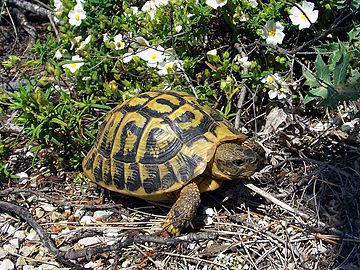| Place of Origin and Range |
These tortoise's can be found throughout southern Europe. The western population is found in eastern Spain, southern France, the Balearic islands, Corsica, Sardinia, Sicily, south and central Italy. The eastern population inhabits Serbia, Kosovo, Macedonia, Romania, Bulgaria, Albania, Greece, Bosnia, Herzegovina, Croatia, and Montenegro. |
| Description |
Hermann's tortoises are small to medium-sized tortoises from southern Europe. Young animals, and some adults, have attractive black and yellow-patterned carapaces, although the brightness may fade with age to a less distinct grey, straw, or yellow colouration. They have slightly hooked upper jaws and, like other tortoises, possess no teeth, just strong, horny beaks. Their scaly limbs are greyish to brown, with some yellow markings, and their tails bear a spur (a horny spike) at the tip. |
| Morph Patterns Available |
Yes |
| Adult Size |
Can grow up to 8in(20cm) |
| Accommodation |
They require large enclosures, temperatures above 60 °F (16 °C), and bedding composed of grasses or grass-based hay. Due to their high dietary fibre needs, grasses form a minimum of 75% of their food intake. Clean, fresh, water should always be present. |
| Lifespan |
Can live 35 + years |
| Feeding / Diet |
These tortoises are herbivores. Primarily, their diets consist of many types of grasses and plants, high in fibre and very low in protein. Feeding of fruit should be avoided. |
| Other Considerations |
Watch for theses health concerns carefully with your tortoise. Vitamin A Deficiency: Vitamin A is an important nutrient for your tortoise’s health. It is found in his diet in the form of leafy green, orange or yellow vegetables, liver, and fish. If your tortoise is not getting enough Vitamin A, he can suffer serious health problems. Always check to make sure that your tortoise does not have swollen eyelids, as this is the main sign of a Vitamin A deficiency. Also, check for weight loss, nasal discharge and infected skin. Any of these symptoms could point to a deficiency. If you think your tortoise may not be getting enough Vitamin A, you should take him to the veterinarian to get a firm diagnosis. Shell Problems: Your tortoise's shell is very important to his overall health. There are many potential problems that could occur, so you should be on the lookout at all times. Respiratory Disease: Respiratory infections have symptoms similar to vitamin A deficiency, including swollen eyelids and runny nose, so you should take your tortoise to the veterinarian to get a proper diagnosis if you suspect either. More serious infections will be characterized by breathing through the mouth, mucus in the mouth, and wheezing. Always make sure your tortoise’s environment has the proper amount of humidity, as this will help prevent respiratory problems. |




